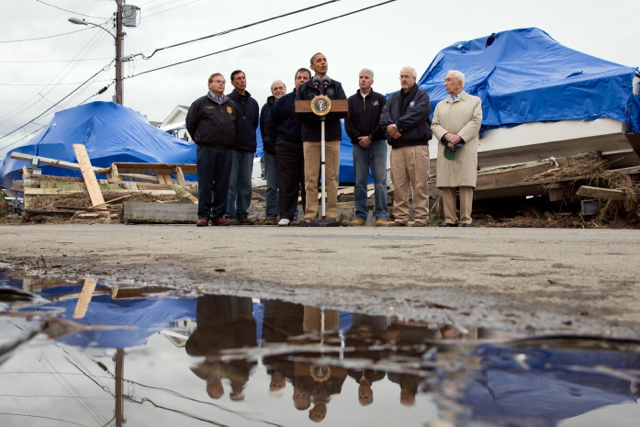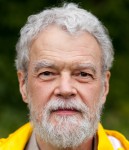 On Monday afternoon as Hurricane Sandy threatened landfall, President Obama warned reporters gathered at the White House that the storm would be a difficult one, and urged a collective, unifying response. In the wake of the storm, Obama has often shifted away from the polarized rhetoric of the campaign trail to a message reminiscent of the candidate circa 2008, employing hopeful metaphors of American unity and healed fracture.
On Monday afternoon as Hurricane Sandy threatened landfall, President Obama warned reporters gathered at the White House that the storm would be a difficult one, and urged a collective, unifying response. In the wake of the storm, Obama has often shifted away from the polarized rhetoric of the campaign trail to a message reminiscent of the candidate circa 2008, employing hopeful metaphors of American unity and healed fracture.
Many scholars who initially saw in Obama the possibility of a reinvigorated prophetic civil religion have since been disappointed. Now, on the eve of the election and as the waters recede across New Jersey and New York City, we have a moment to reflect on the rhetoric and symbolism that Obama has employed during this disaster.
What, if anything, is new about the rhetoric and symbolism he is employing, and how should we understand the relationship between this rhetoric and his governing style? What does it suggest about the arc of American civil religion, about shifting and multiple visions of national solidarity, and about the election and the political climate to follow?
This page was updated on 11/7/2012—ed.
Richard Amesbury, Associate Professor of Ethics, Claremont School of Theology; Associate Professor of Religion, Claremont Graduate University
Robert N. Bellah, an American sociologist and educator, who for 30 years served as professor of sociology at the University of California at Berkeley
Michele Dillon, Professor of Sociology and Chair of the Department of Sociology, University of New Hampshire
Marie A. Eisenstein, Associate Professor of Political Science, Indiana University Northwest
John R. Hall, Professor of Sociology, University of California, Davis
Ebrahim Moosa, Professor of Religion and Islamic Studies, Duke University
Laura R. Olson, Professor of Political Science, Clemson University
Jenna Reinbold, Assistant Professor of Religion, Colgate University
Rhys H. Williams, Professor of Sociology and Chair of the Department of Sociology, Loyola University Chicago
______
 Richard Amesbury, Associate Professor of Ethics, Claremont School of Theology; Associate Professor of Religion, Claremont Graduate University
Richard Amesbury, Associate Professor of Ethics, Claremont School of Theology; Associate Professor of Religion, Claremont Graduate University
Sandy, in all her indiscriminate, non-partisan fury, ripped the facade off two large problems that had received little to no attention in the Presidential debates—poverty and climate change. In the storm’s grim aftermath, President Obama spoke movingly of America’s unity in the face of adversity. “We leave nobody behind,” he said the next day. “We make sure that we respond as a nation and remind ourselves that whenever an American is in need, all of us stand together to make sure that we’re providing the help that’s necessary.” But the reality is that the suffering occasioned by Sandy, though no doubt experienced at all levels, has been unequally distributed. As David Rohde observed in Manhattan the night of the storm, “Those with a car could flee. Those with wealth could move into a hotel. Those with steady jobs could decline to come into work. But the city’s cooks, doormen, maintenance men, taxi drivers and maids left their loved ones at home.” Gestures of bi-partisanship and horizontal solidarity, though perhaps refreshing, should not be allowed to occlude the plight of those left behind in poverty.
Sandy has also made it seem like bad taste to scoff at climate change, as Governor Romney did in his convention speech. Though it may be too early to tell precisely what role climate change played in this particular case, increasingly severe hurricane activity is part of what the scientific models suggest we should expect on our warming planet. Obama’s comment on October 30th is telling: “Sadly, we are getting more experience with these kinds of big impact storms along the East Coast.” Apart from such oblique remarks, and despite pressure from environmental groups, Obama has been mostly silent about the climate of late, but perhaps the images of flooding and devastation will help to change the political climate around climate change, which, like so much else, will most acutely affect the poor.
______
 Robert N. Bellah, an American sociologist and educator, who for 30 years served as professor of sociology at the University of California at Berkeley
Robert N. Bellah, an American sociologist and educator, who for 30 years served as professor of sociology at the University of California at Berkeley
Let me quote from an article I published in Commonweal on March 14th, 2008, entitled “Yes He Can: The Case for Obama”:
Hearing Obama give the keynote address at the 2004 Democratic National Convention was one of the most electrifying experiences of my political life. Who is this person? I thought. How is it possible for anyone today to formulate the very best of the American tradition in such eloquent terms? (Needless to say, with a sense of the centrality of rhetoric to the Western political tradition from Aristotle and Cicero to Lincoln and Martin Luther King, I have never appreciated the derogatory use of the word. I believe that speaking well and thinking well usually go together and vice versa as George W. Bush, who can do neither, so vividly illustrates.
Nothing since has changed my mind. I have been as strongly for Obama as I was from the beginning. “Civil religion” is a contested term. I have long tried to avoid it and it cannot be found in Habits of the Heart. Yet it won’t go away. It is still in play in the United States, and, I learned to my amazement, in China today, to which I made two trips in the fall of 2011 to discuss the idea of civil religion in China among other things. When I reread my original essay of 1967, “Civil Religion in America,” which has become iconic in more circles than I realized, I find I can’t disagree with it. It is not the worship of the state or an effort to “integrate” Americans in loyalty to the U.S. It is a deeply critical call for judgment on this nation, similar to what Durkheim was doing in his defense of Dreyfus. Obama still represents that kind of civil religion, critical but hopeful.
______
 Michele Dillon, Professor of Sociology, the University of New Hampshire
Michele Dillon, Professor of Sociology, the University of New Hampshire
President Obama’s speeches anticipating and responding to Hurricane Sandy are a reminder of the enduring cultural and political significance of America’s civil religion. A recurring emphasis in his statements was Americans’ deeply felt obligation that we have to look out for one another in tough times. This, he reiterated, is the spirit demanded and unceasingly demonstrated in tough times, the spirit that animates Americans’ resilience and their ability to bounce back and do what is necessary “until our work is done.” The virtue of neighbor helping neighbor is a civil religious or sacred belief in the U.S., and it is not merely belief—but belief backed up with practice, as underscored by news accounts of neighbor helping neighbor in devastated neighborhoods. This is what Americans do: whether urban, suburban, or rural, they help their neighbor in need and this is how community solidarity is built, maintained, and regenerated.
Importantly, too, exemplifying that civil religion is equipped to build solidarity across and amidst differences, Obama emphasized that “pulling together” means that “we set aside whatever issues we may have otherwise to make sure that we respond appropriately and with swiftness.” He demonstrated this ethic himself with his energetic 24/7 availability to the governors and state and local officials in need of federal help, an ethos captured in images of Obama embracing his arch-critic Republican Governor Christie as they absorbed New Jersey’s losses. Solidarity, of course, as Durkheim elaborated, entails the sacrificing of the interests and appetites of the self in order to serve a larger communal good. The criticisms of Obama-coziness leveled at Governor Christie by fellow-Republicans underscore the high partisanship of our national politics, and the fact that while the rhetoric of unity can inspire and move us, it is frequently impeded by deliberate barriers to its realization.
On his first day back on the campaign after Sandy, Obama’s speech in Wisconsin was even more explicit in its appeal to themes in America’s civil religion. Whether prompted by the visceral experience of storm victims and politicians pulling together, and/or the (renewed) conviction that he should indeed lead Americans through their continuing challenges, he used unifying language that sought to bind America’s present with its past and its future. At the same time, he was highly critical of political agendas and economic policies that favor the few over the many and elaborated his agenda as one that would make America stronger. But before forcefully outlining those specific partisan issues, he stated:
…we’ve also been inspired these past few days—because when disaster strikes, we see America at its best. All the petty differences that consume us in normal times all seem to melt away. There are no Democrats or Republicans during a storm, there are just fellow Americans. Leaders of different parties working to fix what’s broken; neighbors helping neighbors cope with tragedy; communities rallying to rebuild; a spirit that says, in the end, we’re all in this together—that we rise or fall as one nation, as one people. That spirit has guided this country along its improbable journey for more than two centuries. It has carried us through the trials of the last four years…
If there is a second Obama term, perhaps we will hear more of this binding language and see it entwined into a proactive defense of policies that seek to build a better America. Undoubtedly, the Obama presidency has been confounded by partisan hindrances, exemplified by the shouted charge of “You lie” from a Republican Congressman while Obama was delivering a nationally televised speech on healthcare to Congress in September 2009 (just nine months into his presidency). Similarly too since the Congressional “success” attendant on Newt Gingrich’s Contract with America, there has been a decline in the opportunities for cross-party solidarity formation in Washington, D.C. Despite real and, at times, invidious political and economic challenges, many nonetheless expected President Obama to be an active builder of solidarity, a task that he seemed to shelve for much of his presidency. His Hurricane Sandy statements are a wistful reminder that had he used the civil religious motifs that he can so eloquently muster (remember his Inaugural address)—and that are, in a sense, longed for by Americans as whole—he might have been more effective in generating solidarity among his fellow-Americans in his serious efforts to deal with the financial, economic, health care, and social crises that are now a routine presence in our nation’s life. These crises do not confront us with the graphic images of death, destruction, and tears that appear needed these days for flickers of bipartisanship to emerge. Irrespective of who wins the presidency, however, these are trials that require a civil religious rhetoric and a swiftness of action toward redeeming the promise of America.
______
 Marie A. Eisenstein, Associate Professor of Political Science, Indiana University Northwest
Marie A. Eisenstein, Associate Professor of Political Science, Indiana University Northwest
The most potent rhetoric and symbolism employed by President Obama during the disaster that was and is Hurricane Sandy occurred at a campaign event on November 1st, 2012, in Green Bay, WI. President Obama said that when disaster strikes, Americans put aside their differences; “There are no Democrats or Republicans during a storm, there are just fellow Americans.” This rhetoric reminded me of (Senate candidate) Obama’s 2004 DNC speech where he said, “[T]here’s not a liberal America and a conservative America; there’s the United States of America. There’s not a black America and white America and Latino America and Asian America; there’s the United States of America.” This rhetoric—a rhetoric that emphasized our commonalities and not our differences—is what inspired so many to vote for President Obama in 2008.
While the disaster and tragedy that is Hurricane Sandy gave President Obama an opportunity to highlight his positives—his ability to communicate an American ethos of solidarity, compassion and heroism—it is, quite honestly, too little, too late. The promise of candidate Obama in 2004 and 2008 did not materialize during the tenure of President Obama.
President Obama is capable of soaring rhetoric—rhetoric that once inspired us. But we are also a practical people; we want words to be matched by actions. And many Americans do not believe that President Obama has governed as if there is no separate liberal and conservative America. That is the disappointment.
During this crisis, an example of the American ethos is present in the behavior of Governor Chris Christie. To the dismay of his Republican party, Governor Christie embraced President Obama; in the heat of a tight election, Governor Christie put solidarity with his state and his citizens above all else. That is the American ethos in action. That is what we have not seen from President Obama.
______
 John R. Hall, Professor of Sociology, University of California, Davis
John R. Hall, Professor of Sociology, University of California, Davis
Among the punditocracy, Megastorm Sandy has been called Barack Obama’s October Surprise. Nate Silver, on the other hand, used his November 5th New York Times FiveThirtyEight column to suggest that President Obama’s trending polls toward reelection were “overdetermined,” meaning that multiple factors could reasonably account for Obama’s increasingly favorable position. Both points of view strike me as true.
As Silver points out, a variety of recent developments weighed in Obama’s favor. However, Sandy precipitated a turn toward the affirmation of a collective fate and responsibility—a central theme in America’s “civil religion.” President Obama’s words in this vein became increasingly clear over the course of the storm. “When we go through tough times like this we all pull together,” he said on Monday, October 29th. In the midst of the storm, his rhetoric was purely that of civil religion. And by Thursday, he was introducing his stump speech in Wisconsin with themes of bipartisanship laced with the language of awe, humility, and mourning: “we rise and fall as one nation,” he affirmed.
Obama’s rhetoric was not so strikingly different from that used by all presidents during times of challenge to the nation. What was striking was the contrast to the petty meanness, the bickering, posturing, and unrelenting partisanship that had characterized the election before Sandy arrived. We were reminded that we are a national community. Under ordinary circumstances, such expressions of civility would have merely been expected. During this election, they amounted to something like shock therapy for politics.
______
 Ebrahim Moosa, Professor of Religion and Islamic Studies, Duke University
Ebrahim Moosa, Professor of Religion and Islamic Studies, Duke University
Hurricane Sandy gave President Obama an unprecedented opportunity to mobilize and unify the nation in the face of natural disaster. Obama’s preemptive planning and genuine resolve for an efficient post-disaster recovery shows he can both lead and care at the same time. The wellbeing of the country took priority over partisan politics. Given the president’s electoral blues, Sandy came his way like a mulligan in golf.
It is as if Brutus, of Shakespearean fame, whispered in Obama’s ear:
There is a tide in the affairs of men.
Which, taken at the flood, leads on to fortune.
(Shakespeare, Julius Caesar Act 4, scene 3)
Not only did Obama get a chance to demonstrate his ability to take charge during a crisis, but governor Chris Christie’s endorsement of his leadership was also an unasked gift. Perhaps by tomorrow evening we will know if hurricane Sandy helped Obama to row out of the political shallows.
Indeed, Obama has shown that he genuinely cares for his country. In New Jersey he told folks: “we are here for you, and we will not forget.” George W. Bush said, “we will not forget the events of 9/11”—but then happily went on to wage war in far off countries by forgetting the home front. Obama, in turn, is making promises to flood victims: “we will follow up to make sure that you get all the help that you need until you’ve rebuilt.” These are words of a man confident about a second term in order to supervise the rebuilding effort.
Using military assets for rescue and cleanup in New Jersey and elsewhere is a potent symbol of American civil religion on display during the Obama presidency. Obama wants to turn swords into ploughshares. Determined to end the overseas wars, he solemnly redeploys national assets in the service of nation building at home. Health care, financial legislation in order to regulate Wall Street, promote education and a smart approach to national security—rather than a blundering military machine—appears to be his incomplete work-in-process agenda for national reconciliation, prosperity and fiscal discipline.
Rejecting Republican cynicism, Obama has consistently placed his confidence in the American people. Bipartisanship should be a top priority if he gets another four years. But if faced with Republican obstruction, he should listen to the lyricist of the rhythm and blues (R&B) song and we should tell Obama, not Sally or Sandy: “Ride, Obama, ride…” Hope he listens to us, this time round.
______
 Laura R. Olson, Professor of Political Science, Clemson University
Laura R. Olson, Professor of Political Science, Clemson University
As Hurricane Sandy approached the East Coast, poll after poll showed President Obama widening the gap with Mitt Romney after his disastrous first debate performance. Obama knew the odds of his reelection were increasing (statistically speaking) with every passing day. And weather reports indicated that the storm likely would have its greatest impact on states that already were safely in Obama’s column. What better strategic opportunity for Obama to tweak the national campaign narrative—and even more significantly, the post-election climate—than by stepping into the symbolic presidential role of comforter-in-chief? In this role, crisis transcends political division. People come together across the proverbial aisle. There is, as a younger, more idealistic Obama said in his landmark keynote address at the 2004 Democratic National Convention, “not a liberal America and a conservative America; there is the United States of America.”
Obama knows the inside-the-beltway realities of a second term as president would require him to transcend Washington’s vicious partisanship and bring his actions into line with his trademark rhetoric. He began signaling such an approach in word and deed even before landfall. Invoking vaguely civil religious tones in his November 3 weekly address, he proclaimed:
We’re Americans. When times are tough, we’re tougher. We put others first. We go that extra mile. We open our hearts and our homes to one another, as one American family. We recover, we rebuild, we come back stronger—and together we will do that once more.
Then he met with and hugged people devastated by Hurricane Sandy. Much to the ire of his fellow partisans, New Jersey Governor Chris Christie played a supporting role (as “the warm-hearted Republican who sees the light”) in this drama to perfection.
From the start, Obama genuinely seems to have believed in his personal capacity to unite people of widely divergent political orientations. If reelected, he will need to be far more proactive in pushing for cooperation with Congress. Summoning the better angels of our nature after a superstorm will hardly quiet all of Obama’s partisan foes. But when one of your more vocal critics cannot stop singing your praises, it is a starting point.
______
 Jenna Reinbold, Assistant Professor of Religion, Colgate University
Jenna Reinbold, Assistant Professor of Religion, Colgate University
This election has been a trying time for those of us who long for a vision of American solidarity from the candidates—either of them. (After all, Republicans like solidarity, too.) Although the Romney campaign continues to groan under the burden of its infamous “47 percent” delineation, the Obama campaign has been striking in its own way for its failure to recapture the widespread appeal of the 2008 “hope” and “change” motifs. Surely this is tied in part to the words themselves; “change” is a particularly risky word on which to hang a bid for a second term, as Obama conceded to a Wisconsin audience last week:
You may be frustrated at the pace of change. But you know what I believe. You know where I stand. […] I know what change looks like, because I fought for it. You have, too. And after all we’ve been through together, we sure as heck can’t give up now.
Obama’s assessment is perhaps refreshing in its honesty, but there’s no denying the fact that it smacks much more of sober drudgery than it does of heady transcendence.
As is almost always the case with a disaster, Hurricane Sandy jarred us for a short time from our partisanship. As it figuratively and then literally hovered above Americans of all political persuasions, it furnished the candidates with a chance to spur the national solidarity that so readily congeals in the face of clear, newsworthy adversity. By almost all accounts, Obama wildly outpaced Romney in this endeavor, furnishing us with a reminder of our president’s remarkable—and remarkably underutilized—capacity for rhetorical effervescence.
As Sandy dissipated late last week, however, Obama quickly returned to the business of framing the Republican Party as the biggest disaster of them all—a disaster avertable only by the crucial though admittedly rather tedious cultivation of “a middle-class agenda that rewards hard work and responsibility.”
______
 Rhys H. Williams, Professor of Sociology and Chair of the Department of Sociology, Loyola University Chicago
Rhys H. Williams, Professor of Sociology and Chair of the Department of Sociology, Loyola University Chicago
Disasters—whether natural, human-made, or some combination—are civil religious moments. People are distressed, appalled, fascinated, scared, angry, uncertain. They see themselves in the victims, they feel relief they are not among them, they seek explanations for why this happened and how it might be avoided in the future. If it cannot be avoided, then they want to know it has some meaning.
American Presidents—as the “face” of the nation (our “brand” as it were)—have some responsibility for stepping up and addressing those concerns, and to look like they are themselves searching for answers and working to prevent future event. Thus, not surprisingly, the immediate aftermath of an event produces a type of patriotic and civil religious response among many people. Whether it was the Iranian hostage crisis in 1979, the space shuttle Challenger explosion in 1986, or the recent devastation wrought by Hurricane Sandy last month, we are pulled together momentarily in our concern, and any President has the opportunity (and responsibility) to respond as a reassuring civil religious “priest.” Presidents typically appear immediately on all media, with speeches that assure the nation that this will not permanently damage our society or way of life, that reassert our national resolve to deal with the disaster, and that make the claim that the event actually reveals the basic strength of our national character. They usually end by evoking civil religious blessings on us and our relationship to the Divine. There is usually a “rally around the President” effect and approval ratings typically go way up in the immediate aftermath. We see these things dramatically after 9/11, from President George W. Bush’s approval ratings, to his rhetoric of resilience and re-building, to the ubiquitous flourishing of posters, bumper stickers, billboards and the like that proclaimed “Proud to be an American,” “God Bless America,” “Never forget,” or “United We Stand.” Of course, the President must successfully do these rites of civil religious healing—President Bush’s response to Hurricane Katrina in 2005 is an instructive counter-example.
Thus, President Obama’s response to Hurricane Sandy—including the noted change of rhetoric, body language, and setting (walking devastated beaches) was perfectly attuned to the cultural needs of the moment. Of course it had political benefit—the President is supposed to do, in the minds of many, exactly what he was doing. It is a structural advantage that a challenger can’t possibly grasp equally. Was it a return to 2008, as many claim? Yes, in many ways, particularly given the sense of crisis that pervaded the nation four years ago. Was it politically calculated? Perhaps so. But if we think of “politics” not as a dirty word but as the “authoritative allocation of values” in the broader sense, it should be so. That’s what many Americans look for in a leader.











